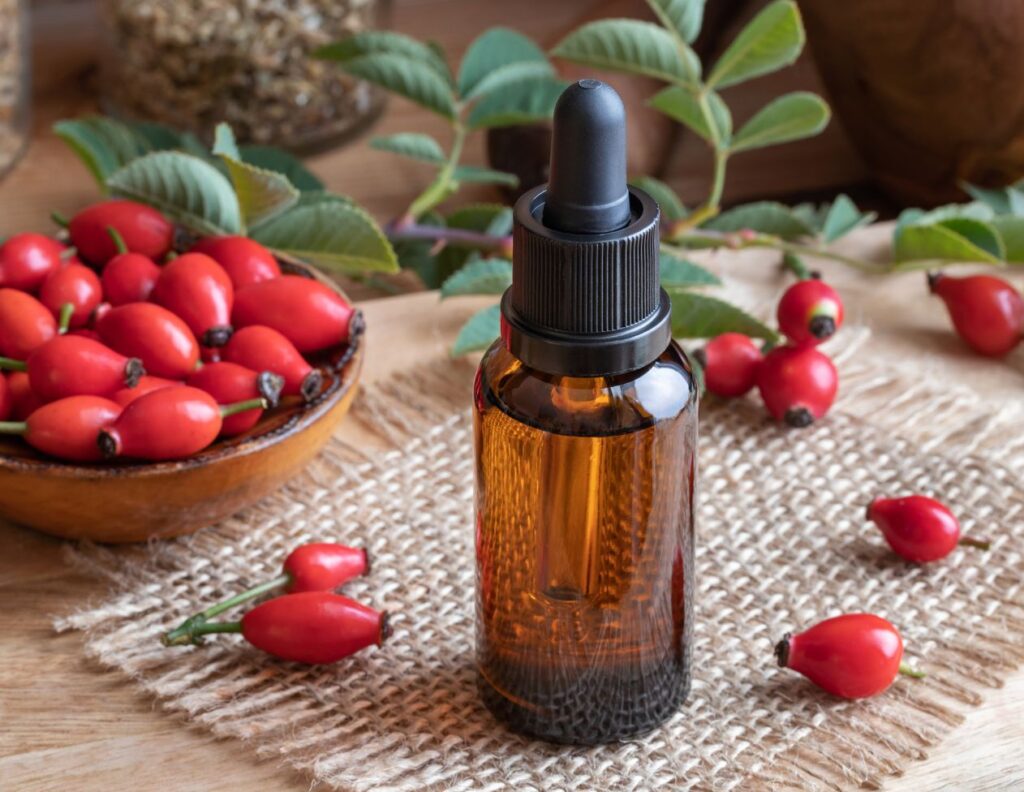Want to learn how to make rosehip tincture for natural immunity? Continue reading and find out how to make this healing tincture.
Rosehip tincture is an amazing natural remedy for boosting natural immunity, anemia, and convalescence since rosehip is the most bioavailable source of natural vitamin C in the world. Before we show you how to make rosehip tincture and use it at home, first, let’s see how to harvest the rose hips.

How to Harvest Rose Hips
The harvesting time for rose hips (Rosa canina) is in September-October, when the berries are well-ripe, meaning that the active principles are at their peak. We can tell if the rosehips are fully ripe by the taste and appearance. Rosehips, depending on the species, can range from red-orange to brick-red in color and have a sweet-sour taste. Do not use soft rosehips that have been affected by frost. Before drying, split the rosehips in four, and remove the seeds.
Dry the rosehips in shaded places, away from moisture, in a very thin layer (ideally the berries should not touch each other). The drying process is quite long, taking about 1-3 weeks, and it is done when the pulp of the berries is completely dehydrated and slightly brittle, breaking easily when cutting the berries with a knife. Do not dry the rosehips in the oven, as heat drying contributes to the inactivation of an enzyme – ascorbinase – which, after harvesting, destroys vitamin C in the berries. After drying, keep the rosehips in gauze bags, or paper bags, and store them in the dark, in dry places.
How to Make Rosehip Tincture
Prepare the rosehip tincture by soaking 2 teaspoons of coarsely chopped dried berries (20 g) in 100 ml of food alcohol (70 degrees) for 10 days. Shake daily. Strain through cheesecloth, after which keep in the refrigerator for 6 days for complete clarification. Gently transfer the clear part into an amber glass bottle with a dropper, preventing any residue that has settled on the bottom of the jar from coming out. Shake the bottle before use. The shelf life of the rosehip tincture is 2 years from the date of preparation.
How to Use Rosehip Tincture at Home
The daily dose is 30 drops of rosehip tincture, 3 times a day, mixed in a little bit of water or herbal tea. This is a natural remedy for the following health problems:
- anemia and lack of appetite
- cardiovascular system problems (heart failure, angina pectoris),
- peripheral circulatory problems (varicose veins, phlebitis, hemorrhoids, capillary fragility)
- respiratory tract problems (tracheitis, bronchitis, bronchial asthma, pneumonia)
- viral conditions (cold, flu, whooping cough)
- urogenital conditions (cystitis, pyelitis)
- metabolic and endocrine conditions (diabetes, thyroid disorders)
- neurological conditions (headaches, migraines, vascular accidents, neurovegetative dystonia)
- age-related conditions (atherosclerosis, senile dementia)
- osteoarticular conditions (arthrosis, spondylosis, coxarthrosis)
Read Also: How to Make Vitamin C with Rosehips
If you’ve enjoyed learning how to make rosehip tincture at home and how to use it for various health problems, please share this article so more people can use this information. Drop a comment below and let us know your experience in making rosehip tincture and what you’ve used it for. Stay healthy, naturally!
Share on Pinterest ❤️

